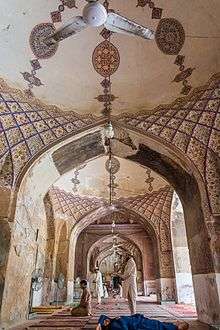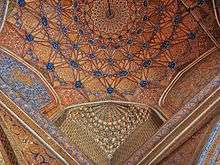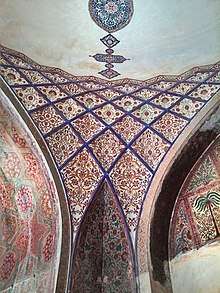Begum Shahi Mosque
Begum Shahi Mosque (Urdu: بیگم شاہی مسجد), officially The Mosque of Mariyam Zamani Begum (Urdu: مریم زمانی بیگم کی مسجد), is an early 17th-century mosque situated in the Walled City of Lahore, Punjab, Pakistan. The mosque was built between 1611 and 1614 during the reign of Mughal Emperor Jahangir in honour of his mother. It is Lahore's earliest surviving example of a Mughal-era mosque,[1][3] and influenced construction of the larger Wazir Khan Mosque a few decades later. This mosque was turned in name of most celebrated Sikh hero Bhai Mani Singh ji, as Shaheed Ganj Bhai Mani Singh, under Sikh rule. [4]
| Mosque of Mariyam Zamani Begum | |
|---|---|
بیگم شاہی مسجد | |
 The building is Lahore's earliest dated Mughal period mosque.[1] | |
| Religion | |
| Affiliation | Islam |
| District | Lahore |
| Province | Punjab |
| Location | |
| Country | Pakistan |
| Architecture | |
| Type | Mosque |
| Style | Indo-Islamic/Mughal |
| Groundbreaking | 1611 |
| Completed | 1614 |
| Specifications | |
| Dome(s) | 3 |
| Materials | Brick[2] |
.jpg)
The mosque has been encroached upon by several shops, and views of the mosque from the Akbari Gate of the Lahore Fort have been obstructed by illegally constructed tyre shops.[5] In July 2016, the Walled City of Lahore Authority announced that the shops would be removed, and the mosque would also be conserved and restored.[6]
Background
The mosque was built during the reign of Mughal Emperor Jahangir in the honour of his mother, Begum Mariam -uz-Zamani, who was also known as 'Maharani Jodha Bai'. The mosque likely served as the main mosque for members that attended the Mughal court.[1]
Location
The mosque is located inside the old Masti Gate in the Walled City of Lahore.
History
Construction began in 1611 and lasted until 1614.[3] Some part of the Mosque was turned into Shaheed Ganj Bhai Mani Singh where as some part of it was temporarily turned into a gunpowder factory by Maharaja Ranjit Singh, for which it was then known as Barudkhana Wali Masjid ("Gunpowder Mosque").[5][3] In 1850 the mosque was returned to the Muslims of Lahore who were able to contribute to its renovation.[2]
Architecture
.jpg)

_of_Mosque.jpg)
The Mosque of Mariyam Zamani Begum represents a transitional phase of architecture, and features both Mughal influences, and influences from the earlier Pashtun Lodi Dynasty which had previously ruled the region.[1] Short domes and wide arches represent the earlier Lodi style, while the mosque's balconies, side rooms, and embellishment are in the Mughal style.[2]
The mosque features Lahore's first five-bay prayer chamber that would later be typical of all later Mughal mosques such as the Wazir Khan Mosque and Badshahi Mosque. The mosque's central bay is in the style of the Persian Char Taq, and is flanked by one smaller dome on either side.[7] The mosque originally had 3 gateways, of which 2 survive.[1]
Layout
The mosque's prayer chamber is 130.5 feet long, and 34 feet wide.[3] The hall is divided into 5 bays, topped by three arches - the largest of which is over the central bay. The mosque also features a courtyard measuring 128 by 82 feet,[8] which has an ablution pool for Islamic ritual washing.[3]
Interior embellishment

The interior of the mosque features extensive Mughal fresco work, and would be the model for the elaborate and extensive frescoes at the Wazir Khan Mosque a few decades later.[1] Most frescoes are floral in design, and calligraphy on the walls includes non-Quranic text, and is the first mosque in Lahore to feature this practice.[3]
Inscriptions
The mosque features inscriptions of Quranic, and non-Quranic origin.[3] An inscription over the northern gateway features a Persian inscription which reads:[2]
God be thanked through whose grace, under the auspices of His Majesty, this building was completed. The founder of the edifice, the place of salvation, is the Queen Mariyam Zamani. For the completion of this edifice, which resembles paradise, I was thinking about when at last I found it in the words "What a fine mosque!"
While the inscription over the eastern gateway reads:[2]
May the Conqueror of the world, King Nur-ud-Din Muhammad, shine in the world like the sun and moon, oh God!
Over an archway on the northern end of the mosque is a final inscription which reads:[2]
So said the Prophet, may the mercy and blessings of God be upon him, "The faithful in a mosque are as fish in water!"
| Wikimedia Commons has media related to Mosque of Mariyam Zamani Begum, Lahore. |
Conservation
Views of the mosque have been obstructed by illegally built shops which have encroached upon the mosque. In July 2016, the Walled City of Lahore Authority announced that the shops would be removed, and the mosque conserved and restored.[6]
Gallery
.jpg) Entry sign
Entry sign Inside Maryam Zamani
Inside Maryam Zamani The mosque has richly embellished muqarnas.
The mosque has richly embellished muqarnas.- The central fountain and ablution area are covered by a new-build canopy.
.jpg)
.jpg)


References
- Asher, Catherine Blanshard (1992). Architecture of Mughal India, Part 1, Volume 4. Cambridge University Press. ISBN 9780521267281. Retrieved 31 August 2016.
- Latif, Syad Muhammad (1892). Lahore: Its History, Architectural Remains and Antiquities. Oxford University: New Imperial Press.
- "Begum Shahi Masjid". Pakistan Today. 12 March 2016. Retrieved 31 August 2016.
- "The mosque that Jodha Bai built". Daily Times. 26 June 2004. Retrieved 5 June 2013.
- "A visual delight – Maryam Zamani and Wazir Khan Mosques". Dawn. 13 May 2015. Retrieved 31 August 2016.
- "Mariam Zamani Mosque to be restored". The Nation (Pakistan). 26 July 2016. Retrieved 31 August 2016.
- Gibb, H. A. R. (1954). The Encyclopaedia of Islam. Brill Archive. Retrieved 30 August 2016.
- Awan, M. Yusuf. "History of Mosque Architecture in Lahore" (PDF). Retrieved 6 October 2017.
.jpg)
